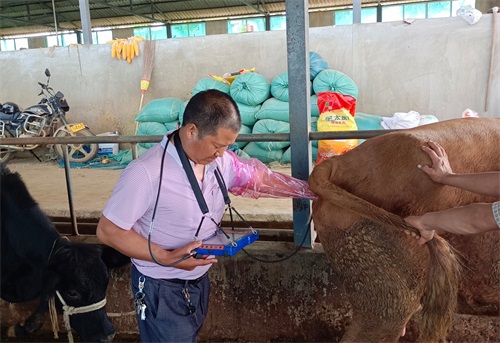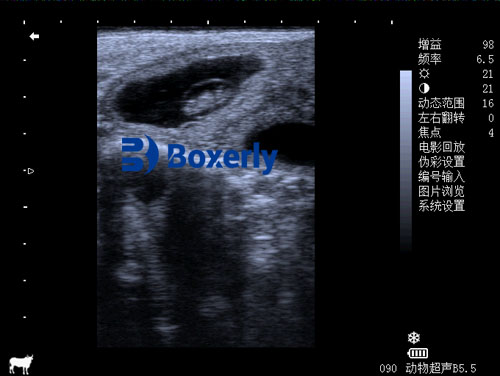How ultrasound reveals health and fertility in dairy cows
For today’s livestock producers, maintaining herd health and improving reproductive efficiency are top priorities. With the growing pressure to increase productivity while ensuring animal welfare, modern diagnostic tools like ultrasound are indispensable. While traditionally associated with human medicine, ultrasound is now a core part of large animal veterinary practice — especially for dairy and beef cattle.
In this article, we’ll explore what ultrasound can tell us about cow health, how it boosts reproductive outcomes, and why it’s becoming an essential tool on both large commercial farms and smallholder operations.
Early pregnancy diagnosis: saving time and boosting profits
One of the most widely adopted uses of ultrasound in cattle is for early pregnancy diagnosis. Unlike traditional rectal palpation, ultrasound provides visual confirmation of pregnancy status as early as 28–30 days post-breeding. This allows producers to make rapid decisions about rebreeding non-pregnant cows and avoid losing valuable time during the calving season.

According to the University of Wisconsin-Madison’s Extension service, using ultrasound for early pregnancy checks can improve calving intervals and increase overall herd reproductive performance[1].
Detecting reproductive tract issues early
Ultrasound also allows veterinarians to identify reproductive disorders such as cystic ovaries, uterine infections, or ovarian inactivity — all of which can cause infertility if left untreated. By visually assessing the uterus and ovaries, vets can tailor treatments more accurately and promptly, improving the chances of conception in subsequent cycles.
This diagnostic advantage reduces the number of open days (the period between calving and successful conception), which directly impacts milk production and farm profitability.
Monitoring fetal development and detecting twins
Beyond simply confirming pregnancy, ultrasound can give detailed insights into fetal health. It can be used to monitor fetal viability, detect twins, and identify abnormal pregnancies such as mummified fetuses or fetal resorption.
Twin detection, in particular, is valuable in dairy herds because twin pregnancies are often associated with higher risk of complications like dystocia (difficult birth) and retained placenta. Identifying these cases early allows producers to plan for assisted calving or modify nutritional programs to support the cow and fetuses.

Improving reproductive planning with ovarian monitoring
Ultrasound is also widely used to monitor ovarian function during artificial insemination (AI) or embryo transfer programs. By observing follicular development and the presence of corpora lutea (yellow bodies), veterinarians can determine the optimal time for insemination or hormone treatments.
This improves conception rates and reduces the costs associated with missed breeding opportunities or failed inseminations. Studies from the University of Florida show that ultrasound-based synchronization protocols improve pregnancy rates in AI programs[2].
Identifying health issues beyond reproduction
Ultrasound isn’t limited to reproductive assessment. It can be used to examine the liver, bladder, rumen, lungs, and even the heart. For instance, ultrasound is useful in diagnosing peritonitis (infection of the abdominal lining), traumatic reticuloperitonitis (hardware disease), and abscesses.
These conditions are often difficult to detect via physical examination alone, but ultrasound provides real-time imaging that helps guide treatment decisions or surgical interventions.
Portable and practical on the farm
One reason for the growing adoption of ultrasound is the availability of rugged, battery-powered, portable ultrasound machines designed specifically for large animal use. These devices can be used chute-side or even in the field without needing a clinic or electricity.
Veterinarians and trained farm personnel can now carry out scans during routine herd checks, significantly improving decision-making on the spot. Some units even come with freeze-frame and video recording capabilities, allowing for follow-up analysis or remote consultation with specialists.
Limitations to be aware of
While ultrasound provides many benefits, it’s important to understand its limitations. For example, it cannot reliably detect very early embryonic loss, nor can it always provide a definitive diagnosis for complex internal diseases without additional testing (like bloodwork or biopsy).
Also, accuracy depends heavily on the operator’s skill and experience. Proper training and frequent practice are essential for interpreting images correctly.
Conclusion: ultrasound is a vital tool for modern cattle farming
Ultrasound technology has revolutionized how farmers and veterinarians manage cattle health and reproduction. It offers quick, non-invasive insights that can guide more effective breeding decisions, identify health problems earlier, and ultimately boost farm productivity.
By incorporating ultrasound into regular herd management, producers can reduce reproductive losses, shorten calving intervals, and improve the well-being of their animals — all of which contribute to more sustainable and profitable operations.
References:
-
University of Wisconsin Extension. “Ultrasound Pregnancy Diagnosis in Dairy Cattle.” https://fyi.extension.wisc.edu/dairy/ultrasound-pregnancy-diagnosis-in-dairy-cattle/
-
University of Florida IFAS Extension. “Reproductive Management of Dairy Cows Using Ultrasound.” https://edis.ifas.ufl.edu/publication/AN317





